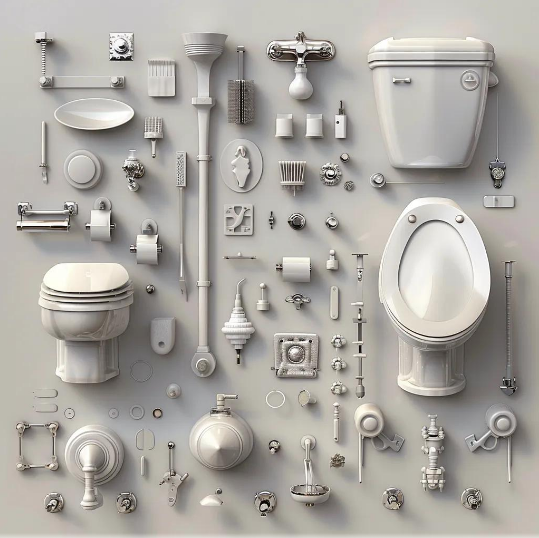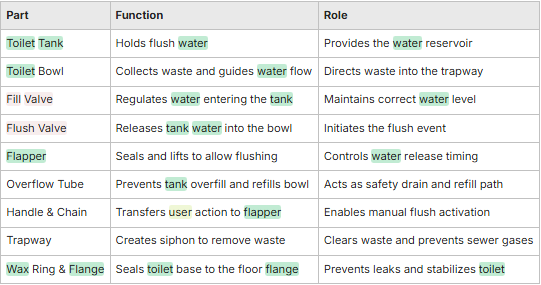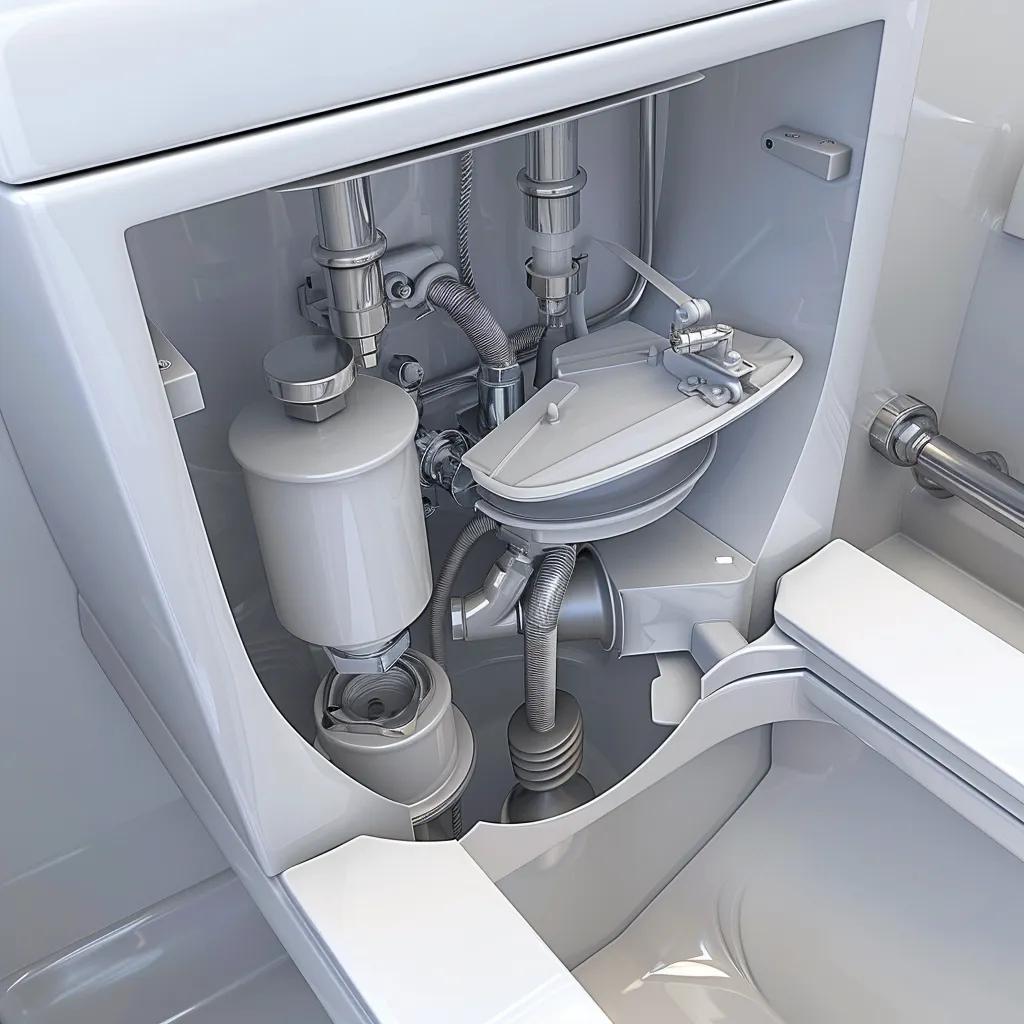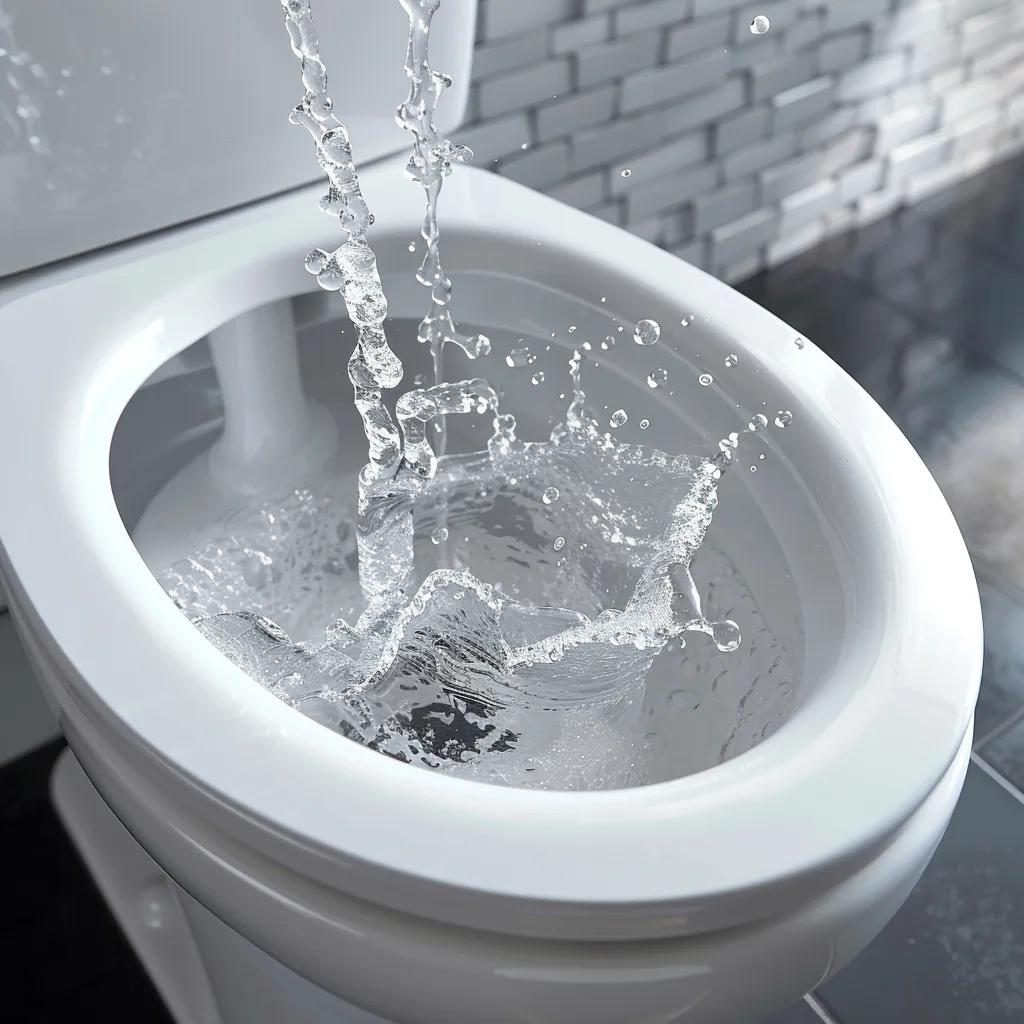
Parts of Toilet and Their Functions
A leaking or weak-flushing toilet can waste hundreds of gallons of water each day, driving up utility bills and causing household frustration. Understanding each toilet component from the tank’s fill valve to the floor’s wax ring, enables precise troubleshooting and smarter maintenance. In this guide, you will learn the main parts of a toilet and how they work together, how to diagnose fill valve and flush valve issues, why the flapper is important, the bowl–trapway synergy, the sealing role of wax rings and flanges, an end-to-end flushing cycle, and when Mitchel Plumbing and Gas can step in for expert repairs.
What Are the Main Parts of a Toilet and How Do They Work?
A toilet comprises several key components that coordinate to flush waste efficiently and refill the tank for the next use. The table below outlines each part’s core function and its primary benefit.
The following table summarises main toilet components, their functions, and practical roles:

Each component in this EAV table works in concert to ensure reliable flushing, and recognising these interactions leads directly into detailed insights on the toilet tank’s workings.
What Is the Role of the Toilet Tank in Flushing?

The toilet tank stores and delivers a measured volume of water that initiates each flush, ensuring waste is carried away with consistent force. By holding water at a precise height, the tank creates the potential energy needed to drive water rapidly into the bowl. Proper tank function enhances flush power and reduces the risk of incomplete bowl clearance, setting the stage for the bowl’s waste-management design.
Toilet Tank Function
The toilet tank's primary function is to store water, which is then released to initiate a flush. The tank's design and the water level maintained within it are important for generating the necessary force to effectively remove waste. Proper tank function is essential for efficient flushing and preventing incomplete bowl clearance.
How Does the Toilet Bowl Manage Waste and Water Flow?
The toilet bowl serves as both a receptacle for waste and a conduit for water flow, leveraging gravity and pressure to guide contents toward the trapway. A specific rim design channels water in a circular motion, rinsing bowl surfaces and sweeping waste into the drain. Efficient bowl design prevents clogs and maintains hygiene by combining splash reduction with optimised water distribution for each flush.
Which Components Inside the Toilet Tank Control Water Flow?
Inside the tank, the fill valve, flush valve, and flapper form a coordinated system that manages water intake and release. The fill valve regulates incoming water until the tank reaches a designated level, the flapper seals the flush valve opening to hold water in the tank, and the flush valve provides the pathway for water to exit when the flapper lifts. These three parts perform the essential hydraulic choreography for tank refill and flushing.
How Do Supporting Parts Like the Overflow Tube, Handle, and Chain Function?
The overflow tube prevents the tank from flooding by redirecting excess water into the bowl, while the flush handle and chain provide the mechanical link to lift the flapper. When the handle is pressed, the chain pulls the flapper upward, momentarily breaking its seal and allowing water to rush through the flush valve. After the flush, the flapper reseats, and the fill valve resumes water intake, referencing the overflow tube’s height to shut off at the correct level.
How Does the Toilet Fill Valve Work and What Problems Can Occur?
A fill valve regulates the inflow of clean water into the tank, closing automatically when the water reaches the preset level to prevent overfill. This mechanism ensures that each flush begins with the correct volume of water, preserving flush strength and preventing continuous running.
What Is the Fill Valve and How Does It Regulate Water Level?
The fill valve is a float-operated assembly that opens to admit water when the tank is empty and closes once the float rises to the designated shut-off point. (Fill Valve) regulates (Water Level) describes this essential relationship. By calibrating float height, the valve maintains consistent tank fill volume, which is key for reliable flushing performance.
Fill Valve Operation
The fill valve regulates the inflow of water into the toilet tank, shutting off automatically when the water reaches a preset level. This mechanism ensures the correct water volume for each flush, maintaining flush strength and preventing continuous running. The fill valve's operation is important for maintaining the proper water level in the tank.
What Are Common Fill Valve Problems and Signs to Watch For?
Homeowners often encounter these fill valve issues:
- Running Toilet: Continuous water flow indicates a valve that won’t close fully.
- Low Water Level: Insufficient refill height causes weak flushes.
- Whistling or Hissing Noises: High-pressure inlet or worn seals create audible warnings.
Each symptom points to internal valve wear or misalignment, suggesting timely inspection and adjustment to prevent wasteful water loss.
When Should You Call a Plumber for Fill Valve Repair?
Persistent running, noisy refill cycles, or an improperly sealing valve signal the need for professional service. A licensed technician from Mitchel Plumbing and Gas can diagnose whether a simple float adjustment or a complete valve replacement is required, ensuring long-term reliability and water savings.
What Is the Flush Valve and How Does It Initiate the Toilet Flush?
The flush valve sits at the bottom of the tank, providing a direct channel for stored water to flow into the bowl when activated. Its swift release action converts potential energy into a powerful flush.
How Does the Flush Valve Release Water into the Bowl?
When the flapper lifts, the flush valve seat opens and allows water to surge downward by gravity. (Flush Valve) releases (Water) into (Toilet Bowl) captures this important event. The rapid outflow scours the bowl surface and initiates the siphon effect in the trapway.
What Are the Flush Valve’s Key Parts: Flapper and Overflow Tube?
The flush valve assembly comprises two main sub-components:
- Flapper: Creates a seal that holds tank water until flush activation.
- Overflow Tube: Ensures excess tank water drains into the bowl rather than spilling externally.
These parts work together to regulate both the flush event and emergency overflow prevention.
What Common Flush Valve Issues Affect Toilet Performance?
Flush valve problems include:
- Weak Flush: A partially lifted or misaligned flapper reduces water release.
- Tank-to-Bowl Leaks: A deteriorated flapper seal causes continuous water seepage into the bowl.
Identifying these issues early preserves flush efficiency and prevents wasted water.
Why Is the Toilet Flapper Essential and How Does It Affect Flushing?
The flapper is the gatekeeper of every flush, sealing the flush valve opening to hold tank water and lifting cleanly to initiate the flush. A well-seated flapper ensures a full flush volume and prevents phantom flushes.
How Does the Flapper Seal the Flush Valve Opening?
Constructed from flexible rubber or polymer, the flapper uses built-in ribs or dimples to snugly press against the flush valve seat. (Flapper) seals (Flush Valve Opening) ensures tank water remains in place, exerting pressure until the handle lifts the flapper to start the flush.
What Causes Flapper Problems Like Ghost Flushing or Leaks?
Common failure modes include:
- Hardened Rubber: Over time, the flapper material loses elasticity and fails to seal.
- Warped Shape: Mineral buildup or age distorts the flapper rim.
- Chain Misadjustment: Too tight or too loose chain prevents proper seating.
These issues lead to intermittent flushing or continuous leaks that waste water and increase bills.
How Can You Troubleshoot or Replace a Faulty Flapper?
To restore sealing integrity:
- Turn off the water supply and flush to empty the tank.
- Disconnect the chain and remove the old flapper from the flush valve posts.
- Install a compatible replacement and adjust the chain slack for a ½-inch lift.
When DIY troubleshooting fails, Mitchel Plumbing and Gas can provide professional installation to guarantee a perfect seal.
How Do the Toilet Bowl, Rim, and Trapway Work Together to Remove Waste?

The toilet bowl, rim, and trapway coordinate to create a siphon effect that clears waste efficiently, combining bowl design and hydraulic action.
What Is the Function of the Toilet Bowl and Rim During a Flush?
The bowl acts as the initial waste receiver, while the rim’s perforated channels distribute water around the bowl circumference. This swirling rinse dislodges debris and directs it toward the trapway entrance, preparing for siphon initiation.
How Does the Trapway Create a Siphon Effect to Clear Waste?
Once water volume and flow exceed a threshold, the trapway’s curved channel pulls bowl contents into a low-pressure zone, creating a vacuum that continues drawing liquid and solids until the bowl is empty. (Trapway) creates (Siphon Effect) illustrates this meronomic relationship.
What Are Common Bowl and Trapway Problems and Their Signs?
Problems often include:
- Partial Clogs: Slow drainage and rising water level.
- Cracked Trapway: Hidden leaks at the base or uneven flush power.
Detecting these signs early prevents overflow and fixture damage.
What Role Do the Wax Ring and Flange Play in Toilet Stability and Leak Prevention?
A wax ring seals the interface between the toilet base and the floor flange, while the flange anchors the fixture and connects to the drainpipe, ensuring stability and leak-proof performance.
How Does the Wax Ring Seal the Toilet Base to the Floor Flange?
A compressible wax ring conforms to irregularities on the toilet’s outlet horn and the flange’s top surface. (Wax Ring) seals (Toilet Base) to (Floor Flange) prevents wastewater from escaping and protects the subfloor from moisture damage.
What Causes Toilet Base Leaks and Rocking Toilets?
Signs of wax ring or flange failure include:
- Water at the Base: Persistent dampness around the toilet footprint.
- Wobbling Fixture: Loose mounting bolts or a deteriorated flange.
These symptoms necessitate a professional flange and seal replacement to avoid structural harm.
When Is Professional Replacement of Wax Ring and Flange Needed?
Whenever a toilet is removed for repairs or shows leak signs beneath the base, Mitchel Plumbing and Gas recommends installing a new wax ring and inspecting the flange condition. Our licensed plumbers ensure precise alignment and secure anchoring to eliminate leaks and rocking.
How Do All Toilet Parts Work Together in the Flushing Cycle?
A flush begins with user action and culminates in tank refill, relying on seamless interactions among multiple components to restore readiness.
What Are the Step-by-Step Actions in a Toilet Flush?
The flushing cycle involves:
- Handle Activation: Handle lifts the chain.
- Flapper Lift: Chain pulls flapper, unsealing flush valve.
- Water Release: Tank water rushes through flush valve into bowl.
- Siphon Initiation: Trapway creates suction and clears waste.
- Flapper Reseating: Flapper returns to seat, sealing the valve.
- Refill Phase: Fill valve opens, refilling tank and bowl via refill tube.
- Valve Shut-Off: Float rises to cutoff level, closing the fill valve.
This sequence illustrates (Handle) activates (Flapper) and culminates with (Fill Valve) regulates (Water Level).
How Do These Parts Interact to Ensure Efficient Flushing?
Each component’s timing and calibration determine flush power and refill consistency. A misadjusted float, misaligned flapper, or obstructed trapway can break the cycle, resulting in weak performance or continuous water flow.
What Common Issues Disrupt the Flushing Cycle?
Frequent cycle disruptions include:
- Handle Slippage: Loose connection to the chain.
- Flapper Drift: Incomplete seal causing partial flushes.
- Fill Valve Failure: Over- or under-filling tank.
Identifying these disruptions leads directly to targeted repairs by a professional.
What Are Common Toilet Problems and How Can Mitchel Plumbing and Gas Help?
Toilet malfunctions often involve specific parts failing to operate as designed, and identifying the root cause ensures the right corrective action.
How to Identify and Fix a Running Toilet?
A continuously running toilet is most commonly caused by a worn flapper or fill valve misadjustment. Replacing the flapper seal or recalibrating the float restores a tight shut-off and prevents water waste.
What Causes Toilet Clogs and When Is Professional Help Needed?
Clogs arise from trapway blockages, foreign objects, or partial bowl rim obstructions. Mild blockages can sometimes be cleared with a plunger, but persistent or recurring clogs require professional inspection to avoid damaging the trapway or drain line.
How to Detect and Repair Toilet Leaks?
Leaks may occur between tank and bowl, at the base flange, or along the water supply line. Visual signs include water on the floor or constant tank refill cycles. Mitchel Plumbing and Gas technicians pinpoint leak sources and replace seals, valves, or mounting hardware to restore integrity.
What Are Signs of a Weak Flush and How to Resolve Them?
A weak flush often signals low tank water level, a partially restricted trapway, or an improperly seated flapper. Adjusting the fill valve, cleaning the trapway, or installing a new flapper enhances flush strength and bowl clearance.
Why Choose Mitchel Plumbing and Gas for Toilet Repair and Maintenance?
With over 15 years of combined experience, our licensed journeyman plumbers bring local Tacoma expertise to every job. We combine quality craftsmanship, prompt service, and transparent pricing to resolve toilet issues swiftly, ensuring your home remains comfortable and water-efficient.
Smooth, reliable flushing depends on the precise function of each toilet component. By understanding how the tank, valves, flapper, bowl, trapway, and seals work together, you can identify issues early and decide when to call professional help. Mitchel Plumbing and Gas is ready to provide expert repairs, installations, and maintenance to keep your toilet performing flawlessly. Trust our decades of local experience to restore proper flushing power and prevent costly water waste.
Recent Post

5 Best Electric Hot Water Systems
Electric hot water systems are one of the most popular choices in Australian homes for their reliability and ease of use. The best electric hot water system is one that efficiently heats water while keeping energy costs down, provides enough hot water for your household's needs, and lasts for many years.

What clogs drains the most?
What if I told you that the most common thing to clog a drain wasn't hair, or food, but something else entirely? What would you say? What if I also

How to fix a dripping tap?
As a young child, I was always fascinated by the world of plumbing. My parents would often find me in the bathroom, watching as my father fixed






.svg)